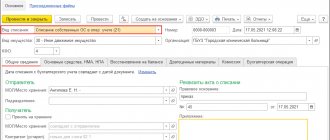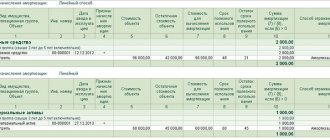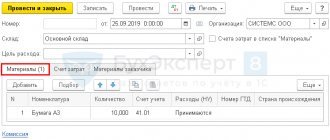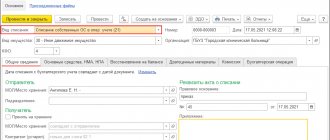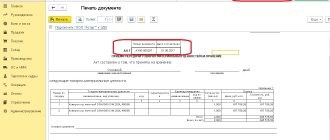In “1C: Accounting 8”, starting with version 3.0.65, you can reflect the gratuitous transfer of goods - gifts, winnings, prizes, promotional items, etc. - using the “Gratuitous Transfer” document. We also talk about the taxation of transactions involving the gratuitous transfer of property.
On the legal regulation, personal income tax taxation of gifts to employees and the procedure for reflecting income in the form of gifts in the 1C: Salaries and Personnel Management 8 program, edition 3, see the article “Gifts to employees: how to register and reflect in 1C.”
We come across the gratuitous transfer of goods, work results and services quite often. These are situations when the following are transmitted:
- gifts for employees and (or) their children;
- gifts to employees of counterparty organizations;
- winnings and prizes in competitions, competitions, games and other events;
- product samples for potential buyers, including food products for tasting;
- printing and souvenir products for advertising purposes;
- goods (work, services) for charitable purposes;
- bonus products;
- stationery and printing products at seminars, conferences and symposiums.
This list can be continued. Sometimes such transfers are due to business customs and traditions accepted in society. Sometimes directly related to economic benefits that can be obtained in the future. In any case, gratuitous transfers allow you to create a positive image of the company.
Let's look at how gratuitous transfers are regulated by civil and tax laws, as well as accounting regulations.
Free transfer: legal regulation, accounting and tax accounting
A gratuitous agreement is an agreement under which one party undertakes to provide something to the other party without receiving payment or other consideration from it (Clause 2 of Article 423 of the Civil Code of the Russian Federation). A gift agreement, an agreement for gratuitous use, a gratuitous agreement for the provision of services - all these are examples of gratuitous agreements. So, for example, under a gift agreement the donor (clause 1 of Article 572 of the Civil Code of the Russian Federation):
- transfers free of charge or undertakes to transfer to the donee an item of ownership or a property right (claim) to himself or to a third party;
- releases or undertakes to release the donee from a property obligation to himself or to a third party.
Donations between commercial organizations are not allowed (clause 4, clause 1, article 575 of the Civil Code of the Russian Federation), and this restriction also applies to individual entrepreneurs (IP) (see Resolution of the Federal Antimonopoly Service of the Central District dated April 16, 2014 in case No. A08-8252/2012 ).
The exception is gifts worth up to 3,000 rubles. (for example, flowers, sweets, business souvenirs, printed products, etc.) transferred to business partners in accordance with business customs.
In accounting, the cost of gratuitously transferred property is recognized as part of other expenses and is reflected in the debit of account 91.02 “Other expenses” in correspondence with the accounts of the transferred property (clauses 11, 17, 19 PBU 10/99 “Organization expenses”, approved. by order of the Ministry of Finance of Russia dated 05/06/1999 No. 33n; Section VIII of the Instructions for the application of the chart of accounts, approved by order of the Ministry of Finance of Russia dated 10/31/2000 No. 94n).
In general, the transfer of ownership of goods (results of work, services) on a gratuitous basis is recognized as a sale and is subject to VAT taxation (clause 1, clause 1, article 146 of the Tax Code of the Russian Federation). The exception is when such transfer:
- is not recognized as an object of taxation, for example, the gratuitous transfer of objects of social, cultural and housing and communal services to state authorities and local governments (clause 2, clause 2, article 146 of the Tax Code of the Russian Federation);
- exempt from VAT taxation, for example, gratuitous transfer of goods (work, services, property rights) within the framework of charitable activities (clause 12, clause 3, article 149 of the Tax Code of the Russian Federation);
If goods (products) are distributed for advertising purposes, then the object of VAT taxation arises only if the advertising materials meet the characteristics of a product, that is, property intended for sale in its own capacity. If advertising materials (flyers, catalogues, brochures, etc.) are transmitted that do not have the characteristics of a product and are part of the activities to promote manufactured and (or) sold goods on the market, then the object of VAT taxation does not arise regardless of the amount of expenses for their acquisition (creation) (clause 12 of the Resolution of the Plenum of the Supreme Arbitration Court of the Russian Federation dated May 30, 2014 No. 33, letters of the Ministry of Finance of Russia dated December 23, 2015 No. 03-07-11/75489, dated December 19, 2014 No. 03-03-06/1/ 65952, dated October 23, 2014 No. 03-07-11/53626).
In accordance with the Tax Code of the Russian Federation, the tax base for VAT is defined as the cost of the transferred property (work, services), calculated on the basis of market prices (Article 105.3, paragraph 2 of Article 154 of the Tax Code of the Russian Federation). VAT should be charged on the day of shipment (transfer) of goods (work, services) to the recipient (clause 1 of Article 167 of the Tax Code of the Russian Federation).
VAT to the budget is paid at the expense of the transferring party (letter of the Ministry of Finance of Russia dated April 16, 2009 No. 03-07-08/90). At the same time, VAT accrued upon gratuitous transfer cannot be taken into account in income tax expenses (clauses 16, 19 of Article 270 of the Tax Code of the Russian Federation).
As for the input VAT presented by the supplier, the tax is subject to deduction in the general manner when the property is accepted for accounting on the basis of the supplier’s invoice and in the presence of primary documents, since the acquired property is used for a VAT-taxable transaction (letter of the Ministry of Finance of Russia dated August 18, 2017 No. 03 -07-11/53088). If, during the gratuitous transfer of property, the donor does not have an obligation to charge VAT (for example, when transferring goods to charity), then the input VAT accepted for deduction when purchasing property is subject to restoration (clause 2, clause 3, article 170 of the Tax Code of the Russian Federation, letter of the Ministry of Finance of Russia dated November 4, 2012 No. 03-07-09/158).
For the purposes of corporate income tax, the gratuitous transfer of property, unlike VAT, is not recognized as a sale, therefore the transferring party does not generate income (letter of the Ministry of Finance of Russia dated October 27, 2015 No. 03-07-11/61618). At the same time, the cost of gratuitously transferred property and expenses associated with such transfer are not taken into account in income tax expenses (clause 16 of Article 270 of the Tax Code of the Russian Federation, letter of the Ministry of Finance of Russia dated September 18, 2017 No. 03-03-06/1/59819 ).
Since the procedure for recognizing expenses for the gratuitous transfer of property in accounting and tax accounting is different, there will be a permanent difference in the assessment of these expenses, which will lead to the formation of a permanent tax liability (clauses 4, 7 PBU 18/02 “Accounting for income tax calculations of organizations ", approved by order of the Ministry of Finance of Russia dated November 19, 2002 No. 114n). As amended by PBU 18/02, approved. By order of the Ministry of Finance of Russia dated November 20, 2018 No. 236n, instead of the concept of “permanent tax liability” (PNO), the term “permanent tax expense” is used.
| 1C:ITS For information on the gratuitous transfer of goods, works and services for VAT purposes, see the “Value Added Tax” reference book in the “Taxes and Contributions” section. |
The essence of gratuitous transfer of property
What is gratuitous transfer of property? According to a common definition, this is a procedure in which a certain subject of legal relations - an individual or an organization - assigns the rights of ownership of some property in favor of other persons, without charging payment in return and without requiring other preferences.
The subjects of the transactions in question can be both commercial enterprises and those institutions that are not related to business. At the same time, in Russian legal practice, the specifics of the participation of organizations with different statuses in procedures for the gratuitous transfer of property may differ. Later in the article we will study the relevant aspect.
The phenomenon under consideration from the point of view of legal classification can be expressed in the form of a gift or donation. It's not the same thing. Many experts believe that there is a significant difference between donation and giving. A little later we will study this aspect in more detail.
Transfer of gifts to individuals
So, donation between a commercial organization and an individual who is not an individual entrepreneur is not prohibited by current legislation (clause 4, clause 1, article 575 of the Civil Code of the Russian Federation). Transfer of a gift worth up to 3,000 rubles. can be committed orally (clause 1 of article 574 of the Civil Code of the Russian Federation).
The cost of gifts received by an individual from organizations or individual entrepreneurs does not exceed 4,000 rubles. per year, not subject to personal income tax (clause 28, article 217 of the Tax Code of the Russian Federation). For a certain category of citizens (for example, for veterans and disabled people of the Great Patriotic War), the cost of gifts, which is not subject to personal income tax, is 10,000 rubles. per year (clause 33 of article 217 of the Tax Code of the Russian Federation).
To receive a tax deduction provided for in paragraphs 28 and 33 of Article 2022 of the Tax Code of the Russian Federation, the transfer of a gift must be confirmed with documents (letter of the Ministry of Finance of Russia dated August 12, 2014 No. 03-04-06/40051). In this case, for personal income tax purposes it does not matter:
- whether the gift is money, a gift certificate or other property;
- whether the recipient is an employee of the organization or not.
It’s a different matter if the gift is an employee’s incentive for conscientious performance of job duties. In this case, the gift is an incentive payment (bonus), which is part of the remuneration (Part 1 of Article 129, Article 131, Article 191 of the Labor Code of the Russian Federation).
A gift within the framework of an employment relationship is subject to personal income tax in full without applying a deduction as income in cash or in kind (clause 6, clause 1, article 208 of the Tax Code of the Russian Federation, clauses 1, 3, 4 of article 210 of the Tax Code of the Russian Federation, p. 2 Article 211 of the Tax Code of the Russian Federation).
An organization does not have an object for taxation of insurance premiums if gifts to employees are transferred under a gift agreement in writing, the value of the gift does not matter (clause 4 of Article 420 of the Tax Code of the Russian Federation, letter of the Ministry of Labor of Russia dated September 22, 2015 No. 17-3/B -473, letter of the Ministry of Finance of Russia dated January 20, 2017 No. 03-15-06/2437).
If the transfer of gifts is carried out within the framework of labor relations, is part of the remuneration system (remuneration for specific labor results) and is of an incentive nature, then the cost of gifts to employees of the organization is subject to insurance contributions (Definitions of the Supreme Court of the Russian Federation dated March 6, 2017 No. 307-KG17-54 in case No. A44-1285/2016, dated 08/27/2014 in case No. 307-ES14-377, A44-3041/2013).
Let's look at how 1C: Accounting 8 (rev. 3.0) reflects the transfer of gifts to individuals.
Example 1
| Modern Technologies LLC applies OSNO, the provisions of PBU 18/02, and pays VAT. In March 2022, the management of Modern Technologies LLC decided to present gifts to its employees and employees of the partner organization (10 gifts in total) at an official event in honor of International Women’s Day. The decision was formalized by order of the head. The cost of each gift is RUB 1,200.00. (including VAT 20% - RUB 200.00). |
The receipt of goods (materials), which are subsequently used to be transferred to individuals as gifts, is reflected in the standard accounting system document Receipt (act, invoice) with the transaction type Goods (invoice) (Purchases section). Let's say an organization purchased 50 ready-made gift sets. After posting the document, the following entries are entered into the accounting register:
Debit 41.01 Credit 60.01 - for the amount of purchased gifts (50,000 rubles). Debit 19.03 Credit 60.01 - for the amount of VAT (10,000 rubles).
For those accounts where tax accounting is supported (in this case, these are accounts 41 and 60; tax accounting is not supported for account 19), the corresponding amounts are entered into special resources of the accounting register for tax accounting purposes (Amount Dt NU and Amount Kt NU).
To register an invoice received from a supplier, fill in the Invoice No. and from fields, then click on the Register button. In this case, the document Invoice received is automatically created, and a hyperlink to the created invoice appears in the form of the basis document. In the form of the document Invoice received by default, the flag Reflect VAT deduction in the purchase book by the date of receipt is selected, which allows you to include the tax amount in VAT tax deductions immediately after gifts are accepted for accounting. If the flag is not set, then the deduction is reflected in the regulatory document Formation of purchase ledger entries.
Starting from version 3.0.65 in 1C:Accounting 8, you can reflect the gratuitous transfer of goods (materials, products) using the Gratuitous Transfer document (Sales section), which allows you to:
- indicate either a specific recipient (for example, when transferring a bonus product to a buyer) or not indicate it at all (for example, when distributing materials for advertising purposes to an indefinite number of people);
- automatically reflect the cost of the transferred property in expenses. The cost account and VAT account are indicated by default as 91.02 “Other expenses” with the analytics Expenses for the transfer of goods (work, services) free of charge and for one’s own needs (profits not accepted for tax purposes);
- charge VAT, which goes into the sales book and into the VAT return. If an organization maintains separate VAT accounting and enters a rate Without VAT, then the data can be reflected in Section 7 of the VAT return;
- reflect the reversal of paid expenses in the book of income and expenses of organizations and individual entrepreneurs using the simplified tax system (KUDiR);
- print documents (Demand-waybill (M-11), Invoice, Consignment note (TORG-12), Universal transfer document (UDD)).
Let's create a document Gratuitous transfer according to the conditions of Example 1 (Fig. 1).
Rice. 1. Document “Free transfer”, tab “Products”
Despite the fact that gifts are transferred to certain individuals specified in the manager’s order, the Recipient field is not required to be filled in. When selling goods free of charge to individuals, there is no need to issue invoices to each of them, since individuals do not deduct VAT.
To reflect accrued VAT in the sales book, it is enough to draw up an accounting statement or a consolidated invoice (letter of the Ministry of Finance of Russia dated 02/08/2016 No. 03-07-09/6171).
On the Products tab, you should specify information about the products transferred for advertising purposes. As the market value of goods in the program, the sales price for the last document is automatically filled in. If the sale price is not determined, then the purchase price is filled in. In Example 1, this is 1,000 rubles.
Since the cost of gifts and the amount of accrued VAT are not taken into account in income tax expenses, on the Cost Account tab you should leave the cost account and VAT account set by default by the program in the appropriate fields (Fig. 2).
Rice. 2. Accounts for expenses when transferring gifts
After posting the Gratuitous Transfer document, the following accounting entries are generated:
Debit 91.02 Credit 41.01 - for the cost of gifts (10,000 rubles). Debit 91.02 Credit 68.02 - for the amount of accrued VAT (2,000 rubles).
For tax accounting purposes for income tax, amounts are entered into special resources of the accounting register:
The amount of Kt NU 41.01 is for the cost of gifts (10,000 rubles). Amount Dt PR 91.02 - for the amounts of permanent differences (10,000 rubles and 2,000 rubles).
If the organization decides to issue a consolidated invoice, then simply click on the Issue invoice button. In the automatically created invoice, dashes are placed in the lines “Consignee and his address”, “Buyer”, “Address”, “TIN/KPP of the buyer” in accordance with the recommendations of the Ministry of Finance of Russia set out in letter dated 02/08/2016 No. 03-07- 09/6171.
A consolidated invoice issued for the gratuitous transfer of goods will be registered in the sales book with the transaction type code “10”, which corresponds to the value “Shipment (transfer) of goods (performance of work, provision of services), property rights on a gratuitous basis” according to the Appendix to Order of the Federal Tax Service of Russia dated March 14, 2016 No. ММВ-7-3/ [email protected]
In the month of transfer of gifts, after processing the Closing of the month and performing the regulatory operation Calculation of deferred tax according to PBU 18, a constant tax expense will be recognized:
Debit 99.02.3 Credit 68.04.2 - in the amount of 2,400 rubles. (RUB 12,000 x 20%).
In the income statement, the cost of the gift transferred and the amount of accrued VAT will be automatically reflected in line 2350 “Other expenses”.
| 1C:ITS For information on how to reflect an individual’s income in the amount of the cost of a gift in 1C solutions, see the reference book “Personnel records and settlements with personnel in 1C programs” in the “Personnel and remuneration” section. |
Postings in accounting
The transferring party makes such entries in its accounting.
- Debit 91 subaccount other expenses Credit 41
- the cost of goods transferred free of charge is written off based on the invoice.
- VAT is charged on the free transfer of goods based on an invoice.
The gratuitous transfer of goods worth more than 3,000 rubles in relations between commercial organizations is prohibited (subclause 4, clause 1, article 575 of the Civil Code of the Russian Federation).
Transfer of winnings and prizes to competition winners
The transfer of winnings and prizes to individuals based on the results of contests, competitions and other events is also recognized as a gratuitous sale and is subject to VAT. In this sense, prizes are no different from gifts.
For profit tax purposes, expenses for the acquisition (production) of prizes awarded to the winners of drawings of such prizes during mass advertising campaigns are considered standard advertising expenses (Clause 4 of Article 264 of the Tax Code of the Russian Federation). Such expenses will be recognized in an amount not exceeding 1% of sales revenue, determined in accordance with Article 249 of the Tax Code of the Russian Federation.
If the holding of a contest or competition does not pursue advertising purposes, is not provided for by a collective agreement and is not included in the remuneration system, then the cost of winnings will not be included in expenses.
As for personal income tax, the cost of winnings and prizes received in competitions, competitions, games is taxed at the following rates (clauses 1, 2 of Article 224, clause 28 of Article 217 of the Tax Code of the Russian Federation):
- 35% - in terms of exceeding 4,000 rubles, if the event is held for the purpose of advertising goods, works and services;
- 13% and without applying a deduction of 4,000 rubles, if the event is held for other purposes (letter of the Ministry of Finance of Russia dated August 20, 2018 No. 03-04-05/58919);
- 13% - in terms of excess of 4,000 rubles, if the event is held according to decisions of the Government of the Russian Federation and representative authorities (letter of the Ministry of Finance of Russia dated November 14, 2018 No. 03-04-06/81966).
Let's look at how in "1C: Accounting 8" (rev. 3.0) you can reflect the transfer of prizes to the winners of a drawing held as part of an advertising campaign.
Example 2
| Modern Technologies LLC is participating in the exhibition in March 2022, where it is holding a prize draw among visitors for advertising purposes. A total of 10 prizes worth RUB 1,200.00 are being drawn. (including VAT 20% - RUB 200.00). The winners are determined by random sampling using a computer program. According to tax accounting data, the amount of expenses for holding prize draws does not exceed 1% of sales revenue for the current reporting period. |
It is also convenient to reflect the transfer of prizes using the Gratuitous Transfer document. The procedure for filling out the Products tab is similar to the procedure described in Example 1. Since prizes are given to an indefinite number of people, the Recipient field also does not need to be filled out.
On the Cost account tab in the Cost account field, you should independently set the required account (for example, account 44.01 “Distribution costs in organizations engaged in trading activities” with the expense type Advertising expenses (standardized)).
According to the Ministry of Finance of Russia and the Federal Tax Service of Russia, expenses in the form of VAT amounts paid by an organization when distributing advertising products free of charge cannot be taken into account when calculating income tax (letter of the Ministry of Finance of Russia dated March 11, 2010 No. 03-03-06/1/123, dated November 20, 2006 No. 02-1-07/92). This conclusion can be extended to the transfer of prizes to the winners of a drawing held as part of an advertising campaign. Therefore, in the VAT Account field, you should leave account 91.02, which is offered by the program by default (Fig. 3).
Rice. 3. Cost accounts for the transfer of prizes as part of an advertising campaign
After posting the Gratuitous Transfer document, the following accounting register entries are generated:
Debit 44.01 Credit 41.01 - for the cost of prizes (10,000 rubles). Debit 91.02 Credit 68.02 - for the amount of accrued VAT (2,000 rubles).
For tax accounting purposes for income tax, amounts are entered into special resources of the accounting register:
Amount Dt NU 44.01 and Amount Kt NU 41.01 - for the cost of prizes (10,000 rubles). Amount Dt PR 91.02 - for a constant difference (2,000 rubles).
In the month of transfer of prizes, after completion of the month-closing processing and completion of the regulatory operation Calculation of deferred tax according to PBU 18, a constant tax expense will be recognized:
Debit 99.02.3 Credit 68.04.2 - in the amount of 400 rubles. (RUB 2,000 x 20%).
The settlement certificate or summary invoice issued upon transfer of prizes will be recorded in the sales book with the transaction type code “10”. The cost of the prizes issued will be included in indirect expenses, which are reflected in the income tax return on line 040 of Appendix No. 2 to Sheet 02.
In the statement of financial results, the cost of prizes is reflected in line 2210 “Business expenses”, and the amount of accrued VAT is reflected in line 2350 “Other expenses”.
| 1C:ITS For information on how to reflect the accrual of VAT for advertising distribution of goods, see the reference book “Accounting for Value Added Tax” in the “Accounting and Tax Accounting” section. |
Gift agreements with the participation of individual entrepreneurs
Transactions whose subject is the transfer of property free of charge in favor of individual entrepreneurs are quite specific. The peculiarity of the corresponding type of legal relationship is that an individual entrepreneur, on the one hand, is not a legal entity. Accordingly, the rule according to which the organization’s property received as a gift must be included in non-operating income may be considered irrelevant for entrepreneurs. On the other hand, for an individual entrepreneur, surprisingly, it might be more profitable to formalize the relevant transaction precisely as a subject of commercial legal relations. Why?
From the point of view of the Tax Code of the Russian Federation, individual entrepreneurs must pay the state, in general, the same types of taxes as a legal entity. That is, it could be an income tax (under the general fee regime) or a transfer of funds within the framework of a “simplified tax regime”. In many cases, the amount of the corresponding fees is lower than the personal income tax, which is 13%. This is exactly the tax rate if an individual receives something as a gift from non-relatives. Obviously, if an individual entrepreneur accepts property free of charge, then it is probably more profitable for him to do this as a subject of commercial legal relations, provided that he and the donor are not relatives.
Reflection of the donation of goods to charity
Charitable activity is considered to be the voluntary activity of citizens and legal entities for the disinterested (free of charge or on preferential terms) transfer of property (including funds) to citizens or legal entities, the disinterested performance of work, the provision of services, and the provision of other support (Article 1 of the Federal Law of 11.08 .1995 No. 135-FZ “On charitable activities and volunteering (volunteering)”). Charitable activities do not mean sending funds or providing assistance in other forms to commercial organizations, political parties, movements, groups (Clause 2, Article 3 of Federal Law No. 135-FZ of August 11, 1995).
The transfer of goods (performance of work, provision of services) within the framework of charitable activities is exempt from VAT in accordance with subparagraph 12 of paragraph 3 of Article 149 of the Tax Code of the Russian Federation. The list of documents confirming the charitable purposes of the gratuitous transfer is not established by law. The Ministry of Finance recommends providing the following documents to confirm the benefit:
- agreement on the provision of charitable assistance with reference to Federal Law dated August 11, 1995 No. 135-FZ;
- an act or other document on the acceptance of property (work, services), signed by the recipient of charitable assistance;
- an act or other document on the intended use of goods (work, services) received (accepted) within the framework of charitable activities.
Amounts of VAT that were previously lawfully accepted for deduction when purchasing goods that were later transferred for charitable purposes are subject to restoration in connection with the use of these goods in activities that are not subject to VAT (clause 2, clause 3, article 170 of the Tax Code of the Russian Federation). For the amount of tax to be restored, an invoice is registered in the sales book, on the basis of which VAT was accepted for deduction (clause 14 of the Rules for maintaining the sales book, approved by Decree of the Government of the Russian Federation of December 26, 2011 No. 1137).
In general, amounts of recovered VAT are taken into account as part of other expenses in accordance with Article 264 of the Tax Code of the Russian Federation. But since the restoration of VAT in this case is not related to production and sales, expenses in the amount of the restored VAT are not taken into account for profit tax purposes on the basis of paragraph 16 of Article 270 of the Tax Code of the Russian Federation. The taxpayer has the right to refuse VAT exemption when transferring goods to charity by submitting a corresponding application to the tax authority no later than the first day of the quarter from which he intends to refuse the exemption. At the same time, refusal of VAT exemption for a period of less than one year is not allowed (clause 5 of Article 149 of the Tax Code of the Russian Federation).
Let's look at how “1C: Accounting 8” (rev. 3.0) reflects the restoration of input VAT on property transferred for charitable purposes.
How to issue an invoice
Since the gratuitous transfer of goods is considered a sale, you will have to issue an invoice in accordance with the general procedure (clause 3 of Article 168 of the Tax Code of the Russian Federation).
Read in the berator “Practical Encyclopedia of an Accountant”
Gratuitous transfer - a special case of implementation
Fill out the invoice in one copy. Two are not needed, since the recipient of the gratuitous goods does not deduct VAT (see letter of the Ministry of Finance dated December 13, 2016 No. 03-03-05/74496).
In the invoice, indicate the market value of the transferred goods and the amount of VAT calculated for payment to the budget.
The market price is the value specified in the contract if the parties are not interdependent (clause 1 of Article 105.3, clause 2 of Article 154 of the Tax Code of the Russian Federation). That is, it is the price at which you sold similar goods to other unrelated parties in the ordinary course of your business.
An invoice must be issued within 5 days from the date of shipment. If the moment of shipment is recorded in the invoice, then within 5 days from the date of its issuance, including the date of registration.
Read in the berator “Practical Encyclopedia of an Accountant”
How to fill out an invoice
